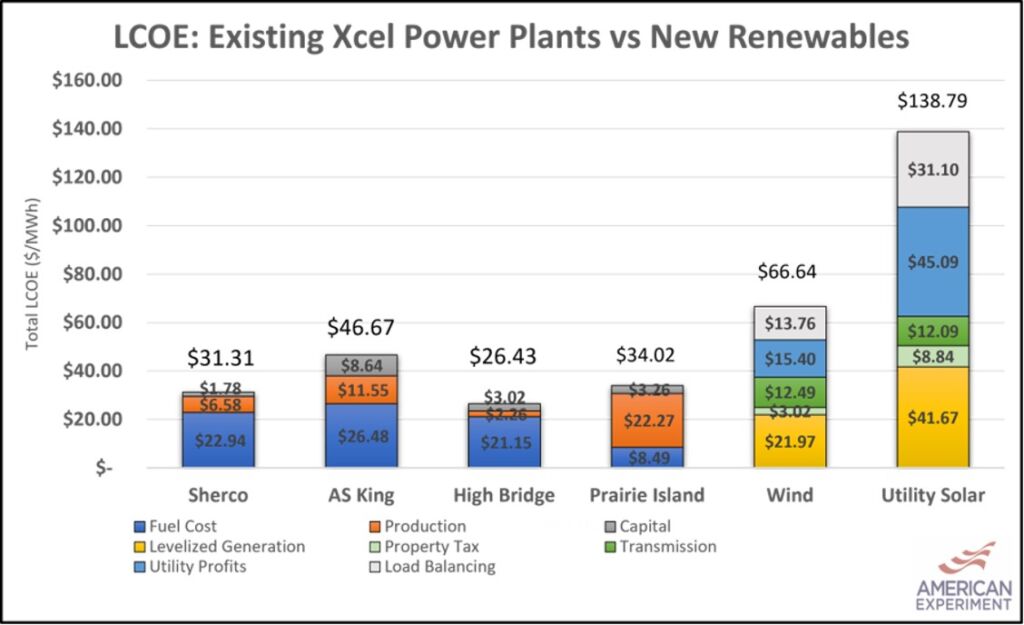Bad news: Minnesota regulators approve Xcel’s premature shutdown of coal facilities
This week, the Minnesota Public Utilities Commission (PUC) voted to allow Xcel Energy to shut down their coal-fired power plants a decade before the end of their useful lifetimes and build a massive number of new wind and solar facilities. This ruling will harm Xcel Energy customers and make the entire energy grid of Minnesota more fragile.
History will not look kindly on this decision.
Fragilizing the grid
The PUC made a deeply flawed decision to shut down some of the most reliable, affordable energy sources in the state of Minnesota and replace them with an expensive and unreliable combination of wind, solar, and a mystery resource called “firm peaking” capacity used to provide electricity to Minnesotans when the sun isn’t shining or the wind isn’t blowing.
Xcel Energy had modeled these “firm peaking” resources as natural gas peaking plants, but wind and solar special interest groups objected, arguing that battery storage should be used to maintain reliability instead. In the end, Xcel caved to the wind and solar groups and both parties agreed to revisit which resource would be used at a later date.
Under this plan, Xcel would also be reliant upon imports from the regional electric grid during periods of low solar and wind output, like the Polar Vortex of 2021. The problem with this strategy is that electric companies in other states, like Consumers Energy in Michigan, think they will be the ones importing power from the grid during these periods.
In the end, everyone will assume someone else will provide them with power when they need it, and there simply won’t be enough reliable power plants left on the system when we need them most. It’s a slow-moving car crash that looks exactly like the California energy example we should all be avoiding.
Killing reliable, affordable energy
Xcel’s coal plants are some of the most reliable, affordable power plants in the state because they have paid off almost all of their capital costs. Closing them down before the end of their useful lifetime is like forcing a family out of their home just after they’ve paid off the mortgage so they can rent somewhere else.
The graph below shows 2019 data from the Federal Energy Regulatory Commission (FERC) comparing the cost of generating electricity from existing coal, natural gas, and nuclear power plants in Xcel’s portfolio against the cost of building new wind and solar installations.
Sherco and AS King, the two coal plants Xcel is seeking to shut down before the end of their useful lifetimes, produced electricity for $31 per megawatt-hour (MWh) and $47 per MWh, respectively. This is a much lower cost than the “all-in” cost of new wind and solar.

Wind and solar advocates often, and intentionally, attempt to confuse people about the cost of wind and solar and the value they provide to the grid.
In this regard, these advocates typically cite the subsidized price of wind and solar, but they conveniently ignore the additional costs incurred through additional utility profits, transmission expenses, property taxes, and the cost of load balancing, which is the cost of building the “firm peaking” plants that are only needed because wind and solar are unreliable.
This is like assessing the size of an iceberg by only looking at the area above the water. But as we know, the subsidized cost of wind and solar is only the tip of the iceberg.

Building a system so heavily reliant upon wind and solar generation will present real reliability concerns in the future.
The graph below shows the performance of Xcel’s coal fleet versus the entire MISO wind fleet during the 2021 Polar Vortex. Xcel’s coal plants generated more electricity than the entire wind fleet during several hours of the cold snap despite the fact that there is eight times more wind capacity on the MISO grid than the installed capacity of these coal plants. Clearly, the coal plants provide a superior value to the grid when we need the energy most.

A lonely silver lining
The one silver lining in the PUC’s decision was to approve the extension of the Monticello nuclear power plant for 10 years. In our testimony, American Experiment said the commission should direct Xcel to instead seek a 20-year extension, but 10 years is better than a closure of the plant.
The PUC’s decision to allow the early coal plant closures and rubber stamping thousands of megawatts of wind and solar will cause electricity prices to increase and electric reliability to suffer. People are beginning to wake up to the harsh reality that energy prices are rising and it is largely due to the policy choices made by legislators and utility commissioners.